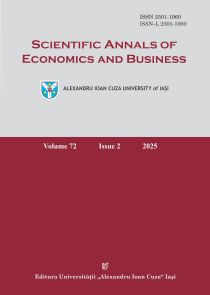The Causal Relationship between Banking, Capital Markets and Economic Growth in the European Union
DOI:
https://doi.org/10.47743/saeb-2025-0022Keywords:
economic growth, financial development, time-series, Granger causalityAbstract
The current paper investigates the causal relationship between financial development and economic growth in 27 European Union (EU) countries. Granger causality tests are applied, using the cointegration and Vector Error-Correction (VEC) methodology. Through the empirical analysis, we found evidence of the presence of Granger causality between finance and growth, sometimes even bi-directional causality, but the nature of the relationship is far from uniform across EU countries. Therefore, a one-size-fits-all approach of policymakers may not be effective for the financial sector to drive economic growth. The results suggest that there are different interactions between the financial sector and economic expansion, based on country specifics, as the causality is sustained by the banking sub-sector in some cases, especially in the case of countries that were part of the former communist bloc, and it is driven by the capital market in other cases. There are also cases in which both financial sectors Granger cause economic growth mostly in the countries that succeeded to better diversify their sources of funding. These findings highlight the presence of financial structural differences among EU countries, and, at the same time, the importance of tailored policies to support further economic expansion.
References
Al-Yousif, Y. K. (2002). Financial development and economic growth: Another look at the evidence from developing countries. Review of Financial Economics, 11(2), 131-150. http://dx.doi.org/10.1016/S1058-3300(02)00039-3
Apergis, N., Filippidis, I., & Economidou, C. (2007). Financial deepening and economic growth linkages: A panel data analysis. Review of World Economics, 143, 179-198. http://dx.doi.org/10.1007/s10290-007-0102-3
Asteriou, D., & Spanos, K. (2019). The relationship between financial development and economic growth during the recent crisis: Evidence from the EU. Finance Research Letters, 28, 238-245. http://dx.doi.org/10.1016/j.frl.2018.05.011
Asteriou, D., & Spanos, K. (2021). The mechanisms linking the finance-growth relationship in view of the financial crisis: An empirical investigation of the EU countries. Journal of Economic Studies (Glasgow, Scotland). http://dx.doi.org/10.1108/JES-03-2021-0170
Brooks, C. (2019). Introductory econometrics for finance: Cambridge University Press. http://dx.doi.org/10.1017/9781108524872
Calderón, C., & Liu, L. (2003). The direction of causality between financial development and economic growth. Journal of Development Economics, 72(1), 321-334. http://dx.doi.org/10.1016/S0304-3878(03)00079-8
Christopoulos, D. K., & Tsionas, E. G. (2004). Financial development and economic growth: Evidence from panel unit root and cointegration tests. Journal of Development Economics, 73(1), 55-74. http://dx.doi.org/10.1016/j.jdeveco.2003.03.002
Čižo, E., Lavrinenko, O., & Ignatjeva, S. (2020). Analysis of the relationship between financial development and economic growth in the EU countries. Insights into Regional Development, 2(3), 645-660. http://dx.doi.org/10.9770/ird.2020.2.3(3)
Dash, S., Pradhan, R. P., Maradana, R. P., Gaurav, K., Zaki, D. B., & Jayakumar, M. (2018). Insurance market penetration and economic growth in Eurozone countries: Time series evidence on causality. Future Business Journal, 4(1), 50-67. http://dx.doi.org/10.1016/j.fbj.2017.11.005
Eliott, J. E. (2017). Review of the book "The theory of economic development" by J. Schumpeter, 1911: Routledge.
Engle, R. F., & Granger, C. W. (1987). Cointegration and error-correction representation, estimation, and testing. Econometrica, 55, 251-276. http://dx.doi.org/10.2307/1913236
FocusEconomics. (2023). Poland Public Debt. Retrieved from https://www.focus-economics.com/country-indicator/poland/public-debt/
Fuinhas, J. A., Filipe, M. D., Belucio, M., & Marques, A. C. (2019). The nexus between financial development and economic growth: Evidence from European countries. Journal of Economics Studies and Research, 1-20. http://dx.doi.org/10.5171/2019.790582
Gaffeo, E., & Garalova, P. (2014). On the finance-growth nexus: Additional evidence from Central and Eastern Europe countries. Economic Change and Restructuring, 47, 89-115. http://dx.doi.org/10.1007/s10644-013-9143-x
Goldsmith, R. W. (1969). Financial Structure and Development: Yale University Press.
Granger, C. W. J. (1988). Some recent developments in a concept of causality. Journal of Econometrics, 39(1–2), 199-211. http://dx.doi.org/10.1016/0304-4076(88)90045-0
Hassan, M. K., Sanchez, B., & Yu, J. S. (2011). Financial development and economic growth: New evidence from panel data. The Quarterly Review of Economics and Finance, 51(1), 88-104. http://dx.doi.org/10.1016/j.qref.2010.09.001
Kar, M., Nazlıoğlu, Ş., & Ağır, H. (2011). Financial development and economic growth nexus in the MENA countries: Bootstrap panel granger causality analysis. Economic Modelling, 28(1-2), 685-693. http://dx.doi.org/10.1016/j.econmod.2010.05.015
King, R. G., & Levine, R. (1993a). Finance and growth: Schumpeter might be right. The Quarterly Journal of Economics, 108(3), 717-737. http://dx.doi.org/10.2307/2118406
King, R. G., & Levine, R. (1993b). Finance, entrepreneurship and growth. Journal of Monetary Economics, 32(3), 513-542. http://dx.doi.org/10.1016/0304-3932(93)90028-E
King, R. G., & Levine, R. (1993c). Financial intermediation and economic development. Capital Markets and Financial Intermediation, 156-189. http://dx.doi.org/10.1017/CBO9780511752056.011
MSCI. (2023). MSCI Market Classification. Assessing and categorizing equity markets according to common characteristics. Retrieved from https://www.msci.com/indexes/index-resources/market-classification
Pagano, M. (1993). Financial markets and growth: An overview. European Economic Review, 37(2-3), 613-622. http://dx.doi.org/10.1016/0014-2921(93)90051-B
Peia, O., & Roszbach, K. (2015). Finance and growth: Time series evidence on causality. Journal of Financial Stability, 19, 105-118. http://dx.doi.org/10.1016/j.jfs.2014.11.005
Robinson, J. (1952). The Generalization of the General Theory The Rate of Interest and Other Essays: MacMillan.
Statista. (2023). Number of monetary financial institutions (MFIs) in the Europe Union as of October 2023, by type. Retrieved from https://www.statista.com/statistics/1111010/european-union-number-monetary-financial-institutions-by-type/
Statista. (2024). Banking industry in Europe. Retrieved from https://www.statista.com/study/25790/banking-in-europe-structure-and-development-statista-dossier/
WB. (2023a). Global Financial Development Database.
WB. (2023b). Trade Has Been a Powerful Driver of Economic Development and Poverty Reduction. Retrieved from https://www.worldbank.org/en/topic/trade/brief/trade-has-been-a-powerful-driver-of-economic-development-and-poverty-reduction
WB. (2023c). World Development Indicators Database. Retrieved from https://databank.worldbank.org/source/world-development-indicators
Wooldridge, J. M. (2012). Introductory econometrics: A modern approach (5th ed. ed.): South-Western Cengage Learning.
Downloads
Published
How to Cite
Issue
Section
License
Copyright (c) 2025 Teodora Palcau, Monica Ioana Pop Silaghi

This work is licensed under a Creative Commons Attribution-NonCommercial-NoDerivatives 4.0 International License.
All accepted papers are published on an Open Access basis.
The Open Access License is based on the Creative Commons license.
The non-commercial use of the article will be governed by the Creative Commons Attribution-NonCommercial-NoDerivatives 4.0 International License as currently displayed on https://creativecommons.org/licenses/by-nc-nd/4.0
Under the Creative Commons Attribution-NonCommercial-NoDerivatives license, the author(s) and users are free to share (copy, distribute and transmit the contribution) under the following conditions:
1. they must attribute the contribution in the manner specified by the author or licensor,
2. they may not use this contribution for commercial purposes,
3. they may not alter, transform, or build upon this work.













